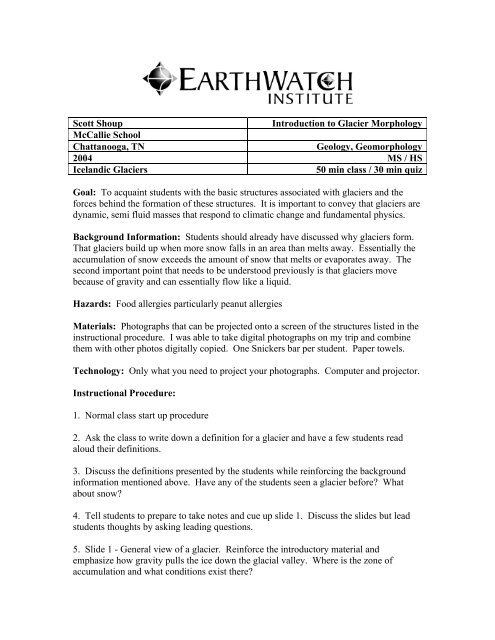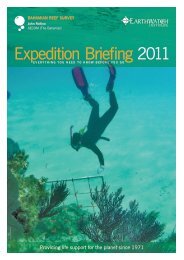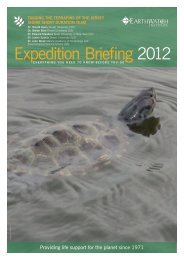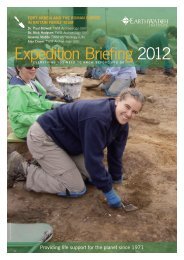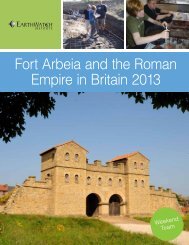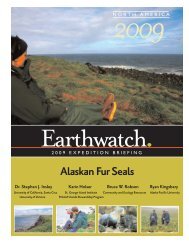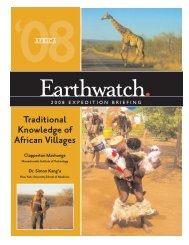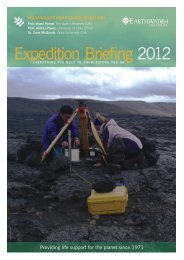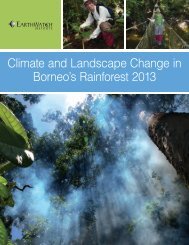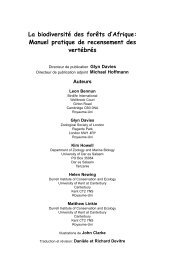Scott Shoup Introduction to Glacier Morphology McCallie School ...
Scott Shoup Introduction to Glacier Morphology McCallie School ...
Scott Shoup Introduction to Glacier Morphology McCallie School ...
Create successful ePaper yourself
Turn your PDF publications into a flip-book with our unique Google optimized e-Paper software.
<strong>Scott</strong> <strong>Shoup</strong> <strong>Introduction</strong> <strong>to</strong> <strong>Glacier</strong> <strong>Morphology</strong><br />
<strong>McCallie</strong> <strong>School</strong><br />
Chattanooga, TN Geology, Geomorphology<br />
2004 MS / HS<br />
Icelandic <strong>Glacier</strong>s 50 min class / 30 min quiz<br />
Goal: To acquaint students with the basic structures associated with glaciers and the<br />
forces behind the formation of these structures. It is important <strong>to</strong> convey that glaciers are<br />
dynamic, semi fluid masses that respond <strong>to</strong> climatic change and fundamental physics.<br />
Background Information: Students should already have discussed why glaciers form.<br />
That glaciers build up when more snow falls in an area than melts away. Essentially the<br />
accumulation of snow exceeds the amount of snow that melts or evaporates away. The<br />
second important point that needs <strong>to</strong> be unders<strong>to</strong>od previously is that glaciers move<br />
because of gravity and can essentially flow like a liquid.<br />
Hazards: Food allergies particularly peanut allergies<br />
Materials: Pho<strong>to</strong>graphs that can be projected on<strong>to</strong> a screen of the structures listed in the<br />
instructional procedure. I was able <strong>to</strong> take digital pho<strong>to</strong>graphs on my trip and combine<br />
them with other pho<strong>to</strong>s digitally copied. One Snickers bar per student. Paper <strong>to</strong>wels.<br />
Technology: Only what you need <strong>to</strong> project your pho<strong>to</strong>graphs. Computer and projec<strong>to</strong>r.<br />
Instructional Procedure:<br />
1. Normal class start up procedure<br />
2. Ask the class <strong>to</strong> write down a definition for a glacier and have a few students read<br />
aloud their definitions.<br />
3. Discuss the definitions presented by the students while reinforcing the background<br />
information mentioned above. Have any of the students seen a glacier before? What<br />
about snow?<br />
4. Tell students <strong>to</strong> prepare <strong>to</strong> take notes and cue up slide 1. Discuss the slides but lead<br />
students thoughts by asking leading questions.<br />
5. Slide 1 - General view of a glacier. Reinforce the introduc<strong>to</strong>ry material and<br />
emphasize how gravity pulls the ice down the glacial valley. Where is the zone of<br />
accumulation and what conditions exist there?
6. Slide 2 – View of compression zone and expansion zones that occur as the ice flows<br />
over bumps (expansion) or in<strong>to</strong> depressions (compression). Point out how the ice spreads<br />
and breaks apart creating crevasses and how these crevasses can actually be closed back<br />
up.<br />
7. Slide 3 – Close view of crevasse. State something <strong>to</strong> express the scale of the<br />
pho<strong>to</strong>graph and mention how crevasses can become covered by snow bridges. This is<br />
why mountaineers stay roped <strong>to</strong>gether when traveling on glaciers. They could potentially<br />
fall in<strong>to</strong> a crevasse hidden by a snow bridge. What would happen <strong>to</strong> a person that fell<br />
in<strong>to</strong> a crevasse if they stayed there for 100 years?<br />
8. Slide 4 – Drains and melt water streams. Melt water streams carry water across the<br />
surface of the glaciers until they reach drains or moulons that allow the water <strong>to</strong> fall<br />
vertically down in<strong>to</strong> the ice. Where does the water go and does it do anything <strong>to</strong> the<br />
glacier?<br />
9. Slide 5 – General surface view of a glacier. How hard would it be <strong>to</strong> travel across this<br />
glacier and what would the dangers be? Also have students create a brief description of<br />
how they might measure movement of the glacier.<br />
10. Slide 6 – Toe or nose of a glacier. If this was an advancing glacier what could you<br />
say about the amount of snow and ice that is lost from this area? If this is a receding<br />
glacier what conditions would exist? Point out how the glacier bulldozes material in<br />
front of it and how dirty the ice becomes. Point out moraines.<br />
11. Slide 7 – Various moraines left by a receding glacier. What can these moraines tell<br />
us about the his<strong>to</strong>ry of the glacier if we know the dates they where put in place? Could<br />
these moraines ever be over run and essentially erased? Could drumlins be formed?<br />
12. Slide 8 – Kettle Lake. These form when ice gets buried or left behind by a glacier.<br />
This buried ice then melts and the dirt on <strong>to</strong>p of the ice falls in<strong>to</strong> the empty hole. This<br />
leaves a depression full of water.<br />
13. Turn on the lights! Hand out snickers bars <strong>to</strong> the students. Be careful about any<br />
students that may have a peanut allergy. Milky Way candy bars can be used as a<br />
substitute. Have them unwrap them completely but don’t eat them!<br />
14. Have students place the candy bar on <strong>to</strong>p of a clean paper <strong>to</strong>wel on <strong>to</strong>p of a clean<br />
surface. Have students press down firmly on the candy bar using their entire hand in a<br />
flat manner. Ideally the candy bar only deforms slightly because the force is distributed<br />
over a large area. You are on a flat surface.<br />
15. Now have the students press in the same manner as they slide the candy bar off the<br />
edge of their surface. This simulates ice traveling off a cliff or over a bump. An
expansion zone is created causing breaks in the upper surface of the candy bar.<br />
Crevasses!<br />
16. Have students flatten their candy bar again by pressing gently on the flat surface.<br />
Notice that the crevasses can be closed and reopened.<br />
17. Now compress the candy bar from either end and you can create pressure ridges.<br />
18. Take a big bite out of the candy bar and look at the cross section. For homework<br />
answer the following questions.<br />
A. If a peanut near the surface of the candy bar was removed causing a surfcae hole <strong>to</strong><br />
form what glacial feature might be represented?<br />
B. If chocolate represented dirt, and caramel ice, describe how the dirt may have come <strong>to</strong><br />
rest on the surface of the glacier.<br />
C. Study your notes on glaciers for a quiz.<br />
Assessment: On the second day spend 30 mins. showing pho<strong>to</strong>graphs of various features<br />
you feel are important. For each pho<strong>to</strong> ask students <strong>to</strong> identify a glacial feature and how<br />
it might have formed.<br />
Suggested Quiz Questions:<br />
1. Wide pho<strong>to</strong> of glacier. What is the definition of a glacier and what must glaciers do?<br />
2. Pho<strong>to</strong> of moraines. What is the name of this feature and why do they form?<br />
3. Pho<strong>to</strong> of crevasses. What are these breaks in the ice called and how are they formed?<br />
4. Same pho<strong>to</strong>. What gives a glacier its tremendous power?<br />
5. Show a picture of a kettle lake. What is this feature and how is it created?<br />
Rubrics for quiz questions:<br />
Allow 10-point bonuses for comments or ideas that show quality thought even if they are<br />
incorrect. This is <strong>to</strong> encourage thinking instead of memorization.<br />
1. (20pts) A glacier is a large mass of moving ice and snow. They must move.<br />
2. (20pts) Moraines. Advancing <strong>Glacier</strong>s push dirt and rock up in<strong>to</strong> hills as they travel<br />
forward.
3. (20pts) Crevasses. They form when ice travels over a bump and the upper surface of<br />
the ice is stretched and broken.<br />
4. (20pts) Gravity and lots of mass.<br />
5. (20pts) Kettle Lake. Buried ice melts creating a cavity or hole that the surface material<br />
falls in<strong>to</strong>. What is left is a hole full of water or a Kettle lake.<br />
Sources used for lesson plan:<br />
Pho<strong>to</strong>graphs taken while on Icelandic <strong>Glacier</strong>s Expedition (should be<br />
available online). Any good geology text with information about glaciers is<br />
useful.<br />
Contact Information: sshoup@mccallie.org


